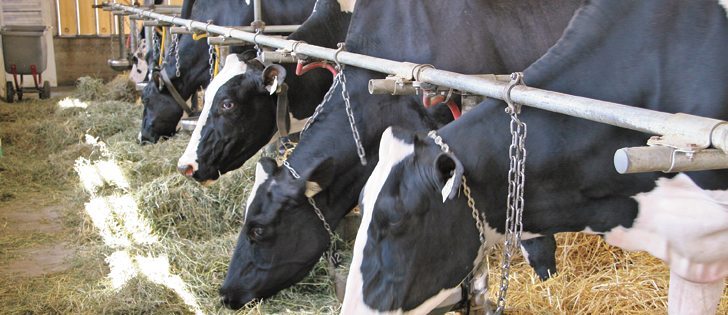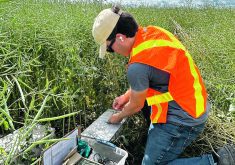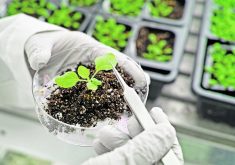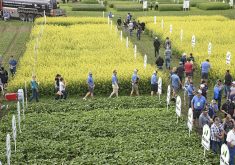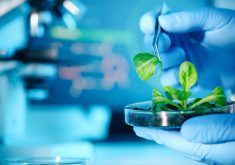Economists often see a dire future for Canadian dairy farming, but asking producers about it will reveal a lot of sunshine punching through the clouds of gloom.
“I’m very positive,” said dairy farmer Matt Plett from Blumenort, Man. “I have more confidence for the future for our kids than I did five years ago, when all this TPP talk started.”
That’s an attitude shared by dairy farmer Ken Vandebrugt of Dewdney, B.C.
“I think the future of dairy farming in Canada is rosy,” said Vanderugt.
Read Also

Crop quality looks good this year across Prairies
Crop quality looks real good this year, with the exception of durum.
“I’m very positive about it.”
Some economists see worrying trends leading to a stagnating and declining industry that will result in an atrophied dairy sector with little economic impact for Canada.
Related: The big squeeze
Related: Dairy’s milky future
But to many farmers, the future today is no more grim than at any time in the past, and they feel more confident now that they think they can finally see the shape of the future.
Dairy farmers say they know what they’ll be dealing with now that the Trans Pacific Partnership and Canada-European Union free trade talks are completed and the deals finalized.
“TPP was looming and as long as it was ongoing, there was a threat and a real fear, but now that it’s behind us, we can plan around it,” said Plett, who has recently bought more quota and increased his operation to three milkings per day.
“We’re on a steady growth path.”
He sees high-efficiency and high quality as his best defences against increased competition in coming years.
To farmers like Plett, it’s not ideal to see foreign dairy processors receive more access to Canada’s protected domestic market, but the small amounts of access aren’t as big as many feared. And with Canada-EU and TPP almost completed, there’s not much else in trade to worry about.
“We have a trade agreement now with everyone that wanted our (supply management) system gone. We’ve been able to hold it intact. There are no other big trade deals looming,” said Plett.
Vandebrugt doesn’t think the trade deals will force him to give up on high-volume milk production. He has gone from 100 cows to 400 since buying his farm from his father 12 years ago and hopes to see his young sons stay in the business.
“I would love to see them in the industry,” said Vandebrugt, who notes that right now the 11-year-old and nine-year-old are more interested in becoming hockey and soccer stars.
However, it won’t be the same business he operates today, which isn’t the same one he took over from his father.
Vandebrugt is in the middle of switching to organic milk production as a way to target the booming urban market that values local and organic production.
That’s not a market easily displaced by cheap foreign imports of skim milk components, which Ontario milk producers such as Peter Dowling of Kingston have been taking steps to counter.
Dowling is also focused on organic milk production, but rather than following Vandebrugt’s commitment to high-volume production, he’s spreading out his risks and keeping dairy as just one component of a mixed farm.
“We’re fairly diversified here,” said Dowling, whose farm employs him, his wife, a son and a daughter. They are producing a variety of commodities, but similar to Vandebrugt are focusing on nearby urban populations that want fresh foods.
“Local is growing in our area.”
Apart from a 25-cow organic dairy operation, which he humorously describes as “a third of a herd,” the farm has a grass-fed beef cattle herd and a farm-to-consumer direct vegetable sales and delivery service.
“It’s all value-added,” said Dowling. “It’d be harder (to do this direct-to-consumer model) in more remote areas.”
Each province has its own regulations, unique dairy farming culture and independent market dynamics.
Some have small land bases but big city populations, offering the potential of a lucrative nearby market for fresh dairy products.
Others, like those on the Prairies, have large land bases and the ability to easily expand but little local consumer demand potential.
Economists say farmers will need to adapt to face the realities of increasing imports, stagnant domestic demand and a virtual ban on exporting dairy products..
Vandebrugt said dairy farming has always been challenged by foreign competitors, domestic critics and the never-ending pressures of agricultural evolution.
However, that’s what has made dairy farmers resolute in the face of situations that have economists fretting: they have grown used to surmounting challenges by doubling down on their commitment to farming.
“You’ve got cows and problems and all this debt and trade deals, and sometimes you wake up and go ‘wow,’ ” Vandebrugt said.
“But you’ve got to be positive. If you’re going to get up every day and be negative, you shouldn’t be in farming.”


